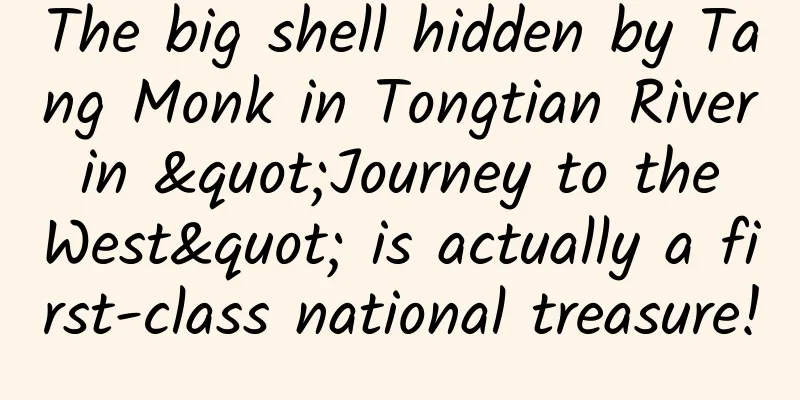The big shell hidden by Tang Monk in Tongtian River in "Journey to the West" is actually a first-class national treasure!

|
Recently, a giant clam weighing 1.5 kilograms was found in the luggage of an incoming passenger at Yinchuan Hedong Airport in Ningxia. Yinchuan Customs confiscated it according to law. This is the heaviest marine endangered species seized in China. The giant clam is the largest bivalve mollusk in the ocean and is known as the "king of shells." In "Journey to the West", the six-foot white stone box where the goldfish monster at the bottom of Tongtian River hid Tang Monk was the shell of a giant clam. As a national first-class protected marine organism, although giant clams can be found on foreign tables, it is strictly prohibited to catch or sell them in China, and violators will be punished according to national laws and regulations. 0 1The King of Shells Culture The Bivalvia are organisms under the phylum Mollusca. Because they mainly live in the sea, have no head (the head has degenerated), and have two symmetrical halves of a valve shell, they are also called the Cephalan class or the Bivalvia class. Among the more than 20,000 bivalve species under the class Bivalve, the largest one is the giant clam. The common giant clam is more than half a meter long and weighs dozens of kilograms; the giant giant clam is more than 1.5 meters long and weighs more than 200 kilograms. It can be called the "king of shells" in the ocean. Foreign fishermen directly use the shells of giant clams as bathtubs for their children. From this, we know that it is entirely possible that the giant clam shells were used as beds in the Dragon Palace in "Journey to the West" or as stone boxes to hide Tang Monk. The working people of China knew about the existence of giant clams more than 2,000 years ago. Giant clams, pronounced chē qú, were called "Chequ" before the Tang Dynasty. "King Wen of Zhou was imprisoned in Youli, and Sanyi found a large clam like a chequ," as recorded in "Shangshu Dachuan". Li Shizhen of the Ming Dynasty explained it in "Compendium of Materia Medica" as follows: "Chequ is a large clam, the large one is two or three feet long and about one foot wide." The name of Chequ has a strong cultural connotation. Its shell has many protruding ridges (professionally called "radial ribs"), and the grooves between the ridges are like the grooves run over by wheels, so it is called "Chequ". Because its shell is as hard as stone, later generations added the character "shi" to its name, which is now commonly known as "giant clam". A golden-buttoned clamshell wine cup unearthed from a tomb of the Sixteen Kingdoms at Nantan Brick and Tile Factory in Xining, Qinghai (Photo source: Museum magazine) Before the Tang Dynasty, people usually used giant clams to make utensils. Documents recorded daily utensils such as bowls and cups, and small objects such as mirrors, wine bowls, and claw hammers unearthed from the Cao Wei Tomb No. 1 in Xizhu Village, Luoyang. After the Tang Dynasty, people preferred to use the inner shell of giant clams to make precious beads. During the Song and Ming Dynasties, giant clams, gold, silver, colored glaze, agate, coral, and amber were revered as the "Seven Treasures of Buddhism". Although the saying of the "Seven Treasures of Buddhism" is slightly different in different documents, giant clams are generally regarded as the first of the seven treasures because of their rare production and beautiful quality like jade. 0 2Hidden in corals and growing together Giant clams are long-lived animals in the ocean, with a lifespan of up to 100 years. Currently, humans have discovered nine types of giant clams, including the giant clams of Cuvier, the devil's giant clams, the giant clams of the long sea, and the giant oyster. Classification of giant clams (Source: Screenshot of the electronic magazine "Museum") Giant clams are mainly found in tropical coral reefs in the Pacific and Indian Oceans. It is difficult to see giant clams on the seabed because they usually grow together with coral reefs and become part of the corals when they grow up. In the rare cases where a colorful giant clam is found far away from the coral reef, what you actually see is only its mantle. The mantle of giant clams is usually yellow, purple or green, and is enlarged and covers the edge of the bivalve, making the shell edge smoother. The mantle has two main functions: first, there are many green circles on it, which can sense the changes in light and darkness; second, there are two tubes on it, one is the water inlet tube for taking in plankton and oxygen, and the other is the water outlet tube for draining excess water. The plankton ingested by the mantle is not the staple food of giant clams. The staple food of giant clams comes from a plant called zooxanthellae. They grow together and depend on each other: giant clams provide living places and nutrients for each other, and zooxanthellae provide food or oxygen for each other through photosynthesis. If the zooxanthellae leave each other due to environmental changes such as seawater pollution and excessive light intensity, the giant clams will bleach or even die! Zooxanthellae hide in coral reefs (Credit: Wooldridge) 0 3 Multiple Values Key Protection Giant clams have multiple values and are a marine organism that is under national key protection. The most basic value of giant clams is their edible value. Giant clams are huge, their meat is crispy and tender, and they are rich in nutrition. Therefore, in foreign countries, especially in Japan, giant clams are one of the most delicious seafood. Foodies eat giant clams with soy sauce, which feels particularly refreshing. The collection and economic value are important manifestations of the inner shell of giant clams. The pearls and stones made from its shell are rich in color, and the carvings and ornaments made from it are very exquisite and are deeply loved by people. The most common color of giant clam pearls is milky white, which is one of the whitest gems in the world. High-end giant clam pearls include golden giant clams, jade giant clams, blood giant clams (rare), etc., with colors such as purple and pink. In addition, the pearls produced by giant clams are very large and expensive. According to the British Daily Mail, Philippine fishermen once found a pearl produced by giant clams weighing 34 kilograms, worth more than 100 million US dollars! Bracelets made of giant clams (Source: Museum magazine) As a member of the marine life, giant clams also have important ecological value. Because they hide in coral reefs and grow symbiotically with zooxanthellae, they can effectively reflect the ecological status of corals and zooxanthellae in the sea. Because giant clams have important edible, collection, economic, and ecological values, after decades of overfishing, giant clam resources around the world have been decreasing sharply, and this is particularly evident in my country. In the early days of liberation, there were more giant clam resources in the Xisha Islands and other islands in the South my country Sea, and along the coast of Taiwan. Fishermen on Hainan Island even used giant clam shells to refine lime raw materials. In the 1980s and 1990s, giant clams in my country's coastal waters were almost extinct. Therefore, in recent years, from the perspective of maintaining biodiversity and protecting the ecological environment, the country has increased its efforts to protect giant clams. It has not only listed Tridacna cuspidatum as a first-class protected marine organism in my country, but also issued relevant laws and regulations to strictly prohibit the illegal fishing, sale, and transportation of giant clams and their products. According to reports, on June 5 this year (the 52nd World Environment Day), the People's Court of Xiangzhou District, Zhuhai City, pronounced a lawsuit. Citizen Yuan was sentenced to one year in prison and a fine of 180,000 yuan for illegally purchasing and selling giant clams online in large quantities. Yuan, who was lucky, certainly did not expect that the big shell related to Tang Monk in "Journey to the West" would cause him such a huge loss. It is really not worth the loss! References: 1. "Research on the Value and Development Status of Giant Clams", author Zhang Yiwei, "Southern Agriculture" 2020 Issue 3 2. “Giant clams have the potential to become a carrier for ancient weather research”, edited by Huang Tongxin, China Science Daily, March 23, 2020 3. "Structural Characteristics of Giant Clams and Similar Shells", by Ou Xiaoya, Li Liping, etc., Gems and Gemology Magazine, Issue 5, 2018 4. "A Study on the Mirror in the Stone Inscriptions of the Cao Wei Tomb in Xizhu Village, Luoyang", author Huo Hongwei, "Museum", 2019, No. 5 Author: Wei Deyong, member of Shenzhen Writers Association, Guangdong Editor: Guru |
<<: It will really make you laugh so hard! Doctors remind you to be careful with these actions
>>: This year, we are heading towards the peak of science
Recommend
A complete set of Android asynchronous task classes
[[123542]] Today I would like to introduce a very...
The 10 most popular growth hacking strategies in China in 2017
Any growth practice starts with small things. In ...
Summary of my experience at Baidu and Meituan: How to build an operations team from scratch!
From entrepreneurship to Baidu, and then to Meitu...
6 data truths about Kuaishou live streaming sales
If we say that there are already three top stream...
It turns out that it is also an important factor in improving download conversion!
In order to further optimize the user experience ...
Analysis of Hema fresh food products!
Since its establishment in 2016, Alibaba's He...
Pinduoduo’s strategic techniques for user growth!
In the war among many e-commerce giants, Pinduodu...
SEM promotion from word selection to optimization, 3 major routines!
In SEM advertising, we often spend most of our ti...
Does avian influenza specifically infect poultry? Can it directly infect humans?
The full name of avian influenza is avian influen...
Android watch high-definition Korean drama permanent membership version_Resource headlines
Login has been modified to show permanent members...
How to deploy a huge amount of Qianchuan when cold starting a new account?
This article will explain what actions need to be...
How can copy impress your users? Let’s add one more sentence: And then what?
When you go shopping, have you ever felt that som...
Is walking too slowly a "sin"? Even walking has so many rules?
Some references: [1] Liang Yi, On the Concept and...
Operation means having a love relationship with users!
My understanding of user operations Operational w...
Tieli SEO Training: What factors affect SEO traffic?
Doing SEO is nothing more than wanting to have tr...









